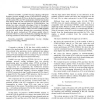Free Online Productivity Tools
i2Speak
i2Symbol
i2OCR
iTex2Img
iWeb2Print
iWeb2Shot
i2Type
iPdf2Split
iPdf2Merge
i2Bopomofo
i2Arabic
i2Style
i2Image
i2PDF
iLatex2Rtf
Sci2ools
TSP
2016
2016
Parallel Two-Way Relaying in Cooperative OFDMA Cellular Systems
—Consider a parallel two-way relaying orthogonal frequency division multiple access (PTWR-OFDMA) scheme in which mobile terminals (MTs) are divided into near-nodes (NNs) and far-nodes (FNs). An NN communicates with the base station (BS) directly while an FN communicates indirectly via NNs. We study the design and analysis issues for PTWR-OFDMA. The scheme has some noticeable advantages. First, its throughput increases like lnK, much higher than that of lnlnK in conventional OFDMA (K being the number of MTs). Second, PTWR-OFDMA can provide much better fairness than conventional OFDMA. Third, the power overhead per NN reduces quickly when K increases if there is a peak rate limitation, implying that there is no strong incentive for some users to avoid providing relaying. Keywords—cooperative communication; two-way relaying; analog network coding; OFDMA
TSP 2016 |
| Added | 11 Apr 2016 |
| Updated | 11 Apr 2016 |
| Type | Journal |
| Year | 2016 |
| Where | TSP |
| Authors | Sai Jin, Li Ping |
Comments (0)

